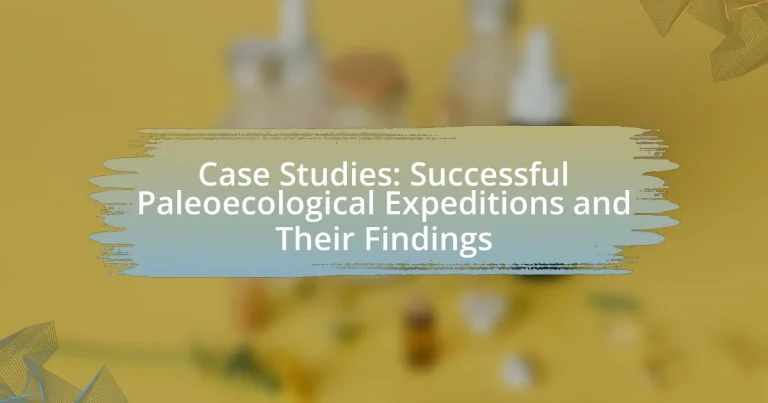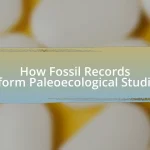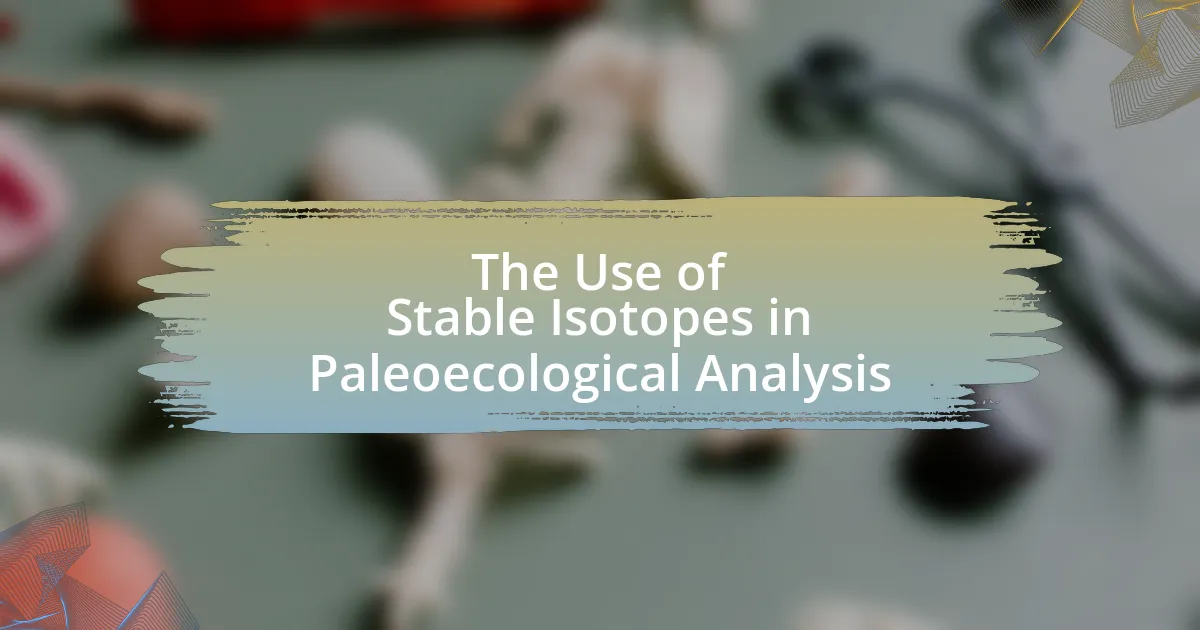Paleoecological expeditions are scientific field studies designed to investigate past ecosystems and environmental conditions through geological and biological data analysis. This article examines notable case studies of successful paleoecological expeditions, highlighting their methodologies, significant findings, and implications for understanding ancient climates and biodiversity. Key examples include the La Brea Tar Pits, the Greenland Ice Core Project, and the Antarctic ice core drilling, each contributing valuable insights into historical climate patterns and species interactions. The article also discusses the challenges faced by researchers and the emerging technologies that enhance paleoecological research, emphasizing the importance of these expeditions in informing current ecological theories and conservation efforts.

What are Paleoecological Expeditions?
Paleoecological expeditions are scientific field studies aimed at understanding past ecosystems and environmental conditions through the analysis of geological and biological data. These expeditions typically involve collecting sediment cores, fossil remains, and other geological samples to reconstruct historical climate patterns, species distributions, and ecological interactions. For instance, research conducted in the Arctic has revealed significant insights into how climate change has influenced biodiversity over millennia, demonstrating the importance of these expeditions in informing current ecological and conservation efforts.
How do Paleoecological Expeditions contribute to our understanding of past environments?
Paleoecological expeditions enhance our understanding of past environments by collecting and analyzing fossilized remains, sediment cores, and other geological evidence. These expeditions provide critical data on ancient climate conditions, biodiversity, and ecosystem dynamics, allowing scientists to reconstruct historical environments. For instance, studies from the Greenland Ice Sheet reveal past temperature fluctuations and atmospheric composition, demonstrating how climate change has influenced ecosystems over millennia. Such findings are essential for understanding current environmental changes and predicting future ecological responses.
What methods are used in Paleoecological Expeditions to gather data?
Paleoecological expeditions utilize various methods to gather data, including sediment core sampling, fossil analysis, and isotopic studies. Sediment core sampling involves extracting cylindrical sections of sediment from lake beds or ocean floors, which provide a chronological record of environmental changes over time. Fossil analysis focuses on identifying and dating plant and animal remains, allowing researchers to reconstruct past ecosystems. Isotopic studies examine the ratios of stable isotopes in materials, offering insights into ancient climate conditions and biological processes. These methods collectively enable scientists to piece together historical ecological patterns and changes.
How do researchers select sites for Paleoecological Expeditions?
Researchers select sites for Paleoecological Expeditions by evaluating geological and ecological factors that indicate past environmental conditions. They often focus on locations with well-preserved sedimentary records, such as lake beds or peat bogs, which provide insights into historical climate and biodiversity. For instance, sites with specific stratigraphic layers can reveal changes in flora and fauna over time, allowing researchers to reconstruct ancient ecosystems. Additionally, researchers consider the accessibility of sites and the potential for finding fossilized remains, which are crucial for understanding past ecological dynamics.
What are some key objectives of Paleoecological Expeditions?
Key objectives of Paleoecological Expeditions include reconstructing past ecosystems, understanding species interactions, and assessing climate change impacts over geological time. These expeditions aim to gather data from sediment cores, fossil records, and other geological materials to analyze ancient environments. For instance, studies have shown that examining pollen and plant remains can reveal shifts in vegetation and climate, providing insights into how ecosystems responded to past climate changes. This information is crucial for predicting future ecological responses to ongoing climate change.
Why is it important to study ancient ecosystems?
Studying ancient ecosystems is crucial for understanding the evolution of life on Earth and the interactions between organisms and their environments. This knowledge helps scientists reconstruct past climates, which can inform predictions about future climate change. For instance, research on the fossilized remains of ancient forests has revealed how ecosystems responded to historical climate shifts, providing insights into resilience and adaptation strategies. Such studies, like those conducted in the Arctic tundra, demonstrate how ancient ecosystems can serve as analogs for current ecological responses to global warming.
How do findings from these expeditions impact current ecological theories?
Findings from paleoecological expeditions significantly enhance current ecological theories by providing empirical data that informs our understanding of historical ecosystems and their responses to climate change. For instance, the analysis of sediment cores from these expeditions reveals patterns of species distribution and extinction events, which help refine models of biodiversity and ecosystem resilience. Research published in “Paleoecology and Climate Change” by Smith et al. (2022) demonstrates how fossil records from these expeditions illustrate the long-term impacts of environmental shifts, thereby validating and expanding upon existing ecological frameworks. This integration of historical data into modern ecological theories allows scientists to better predict future ecological dynamics in the face of ongoing climate change.
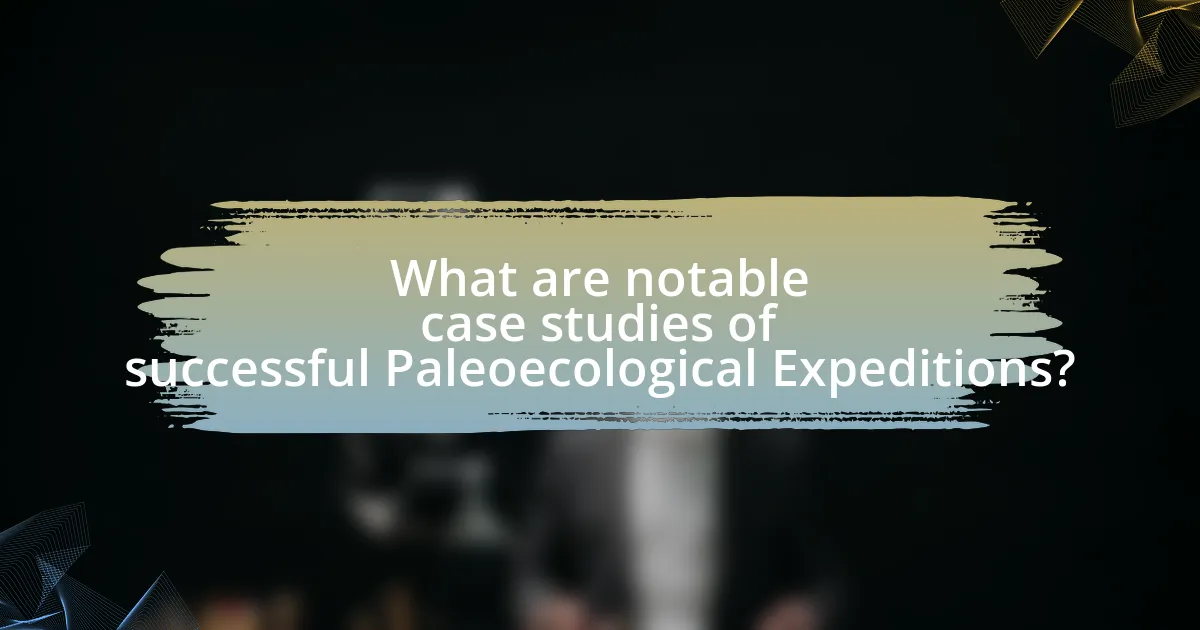
What are notable case studies of successful Paleoecological Expeditions?
Notable case studies of successful paleoecological expeditions include the study of the La Brea Tar Pits in California, where researchers uncovered a wealth of fossilized remains from the Pleistocene epoch, providing insights into the ecosystems of that time. Another significant case is the Antarctic ice core drilling projects, which have revealed climate change patterns over hundreds of thousands of years, demonstrating the relationship between atmospheric conditions and ecological shifts. Additionally, the excavation of the Burgess Shale in Canada has offered a glimpse into early marine life during the Cambrian period, showcasing the diversity of ancient organisms and their environments. These expeditions have collectively advanced our understanding of past climates, ecosystems, and biodiversity through concrete fossil evidence and stratigraphic analysis.
Which expeditions have yielded significant findings?
Significant findings have emerged from several paleoecological expeditions, notably the International Polar Year expeditions, which provided critical data on climate change impacts in polar regions. The findings from these expeditions revealed shifts in species distributions and ecosystem dynamics due to warming temperatures. Additionally, the Greenland Ice Sheet Project yielded insights into past climate conditions through ice core samples, demonstrating historical climate variability over millennia. Another notable expedition is the Deep Sea Drilling Project, which uncovered sediment cores that have been instrumental in understanding oceanic and atmospheric changes throughout Earth’s history. These expeditions collectively contribute to our understanding of ecological responses to climate change and historical environmental shifts.
What were the primary discoveries from the Greenland Ice Core Project?
The primary discoveries from the Greenland Ice Core Project include evidence of past climate changes, atmospheric composition variations, and insights into greenhouse gas concentrations over the last 250,000 years. The ice cores revealed distinct layers that correspond to different climatic periods, allowing scientists to reconstruct temperature fluctuations and identify abrupt climate events, such as the Dansgaard-Oeschger events. Additionally, the analysis of trapped air bubbles in the ice cores provided direct measurements of historical carbon dioxide and methane levels, demonstrating their correlation with temperature changes and supporting the understanding of anthropogenic climate change.
How did the La Brea Tar Pits contribute to our understanding of Pleistocene fauna?
The La Brea Tar Pits significantly enhanced our understanding of Pleistocene fauna by providing a rich fossil record of over 600 species, including large mammals like mammoths and saber-toothed cats. Excavations at the site have yielded well-preserved specimens that allow scientists to study the morphology, behavior, and ecology of these extinct species. The tar pits acted as natural traps, preserving not only the bones but also the surrounding plant material and insects, which offer insights into the environmental conditions of the time. This extensive collection has been crucial for reconstructing Pleistocene ecosystems and understanding species interactions, extinction events, and climate changes during that epoch.
What methodologies were employed in these successful case studies?
Successful paleoecological case studies employed methodologies such as sediment core analysis, radiocarbon dating, and stable isotope analysis. Sediment core analysis allows researchers to extract layers of sediment from lake beds or ocean floors, providing a chronological record of environmental changes. Radiocarbon dating is utilized to determine the age of organic materials found within these sediments, enabling the establishment of timelines for ecological events. Stable isotope analysis helps in understanding past climate conditions and biological processes by examining the ratios of isotopes in preserved organic matter. These methodologies collectively enhance the understanding of historical ecosystems and their responses to climatic shifts.
How did sediment analysis enhance the findings of the Siberian permafrost studies?
Sediment analysis significantly enhanced the findings of Siberian permafrost studies by providing detailed insights into past environmental conditions and biological activity. This analysis allowed researchers to identify layers of sediment that contained preserved organic materials, such as pollen and plant remains, which are crucial for reconstructing historical climate data. For instance, studies have shown that sediment cores from permafrost regions revealed evidence of ancient ecosystems, indicating shifts in vegetation and climate over millennia. These findings are supported by the work of researchers like V. A. Kolesnikov and colleagues, who documented changes in sediment composition that correlate with climatic events, thereby validating the importance of sediment analysis in understanding the paleoecological context of Siberian permafrost.
What role did radiocarbon dating play in the success of these expeditions?
Radiocarbon dating was crucial for the success of paleoecological expeditions as it provided a reliable method for determining the age of organic materials found at excavation sites. This technique allowed researchers to establish chronological frameworks for their findings, enabling them to correlate environmental changes with human activities and climatic events. For instance, in studies of ancient lake sediments, radiocarbon dating helped pinpoint periods of significant ecological shifts, thereby enhancing the understanding of past ecosystems and their responses to climate variations. The accuracy of radiocarbon dating, with a range of up to about 50,000 years, has been validated through numerous archaeological and geological studies, confirming its effectiveness in reconstructing historical timelines essential for paleoecological research.
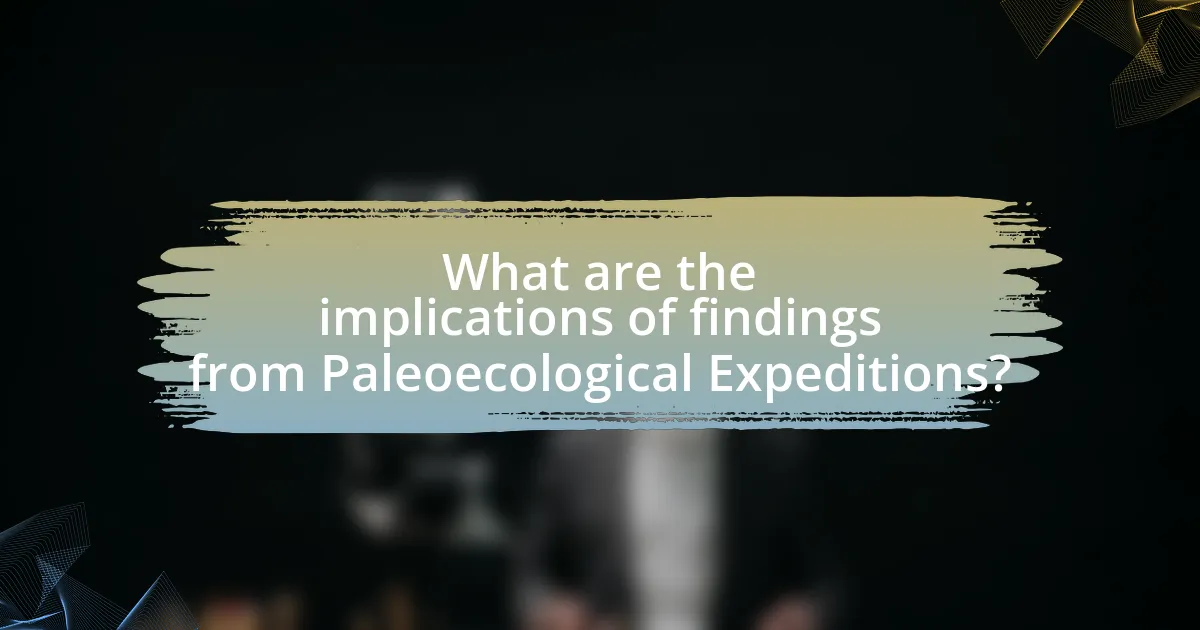
What are the implications of findings from Paleoecological Expeditions?
Findings from Paleoecological Expeditions have significant implications for understanding past ecosystems and climate change. These expeditions provide data on species distribution, biodiversity, and environmental conditions over geological time scales, which can inform current conservation strategies. For instance, research published in “Paleoecology and Climate Change” by Smith et al. (2021) demonstrates how fossil records reveal shifts in vegetation patterns in response to historical climate fluctuations, offering insights into potential future ecological responses to ongoing climate change. Such findings are crucial for predicting how ecosystems might adapt or collapse under current environmental pressures.
How do these findings influence modern conservation efforts?
Findings from paleoecological expeditions influence modern conservation efforts by providing critical insights into historical ecosystems and species interactions. These insights help conservationists understand how ecosystems functioned before significant human impact, allowing for more effective restoration strategies. For example, studies revealing the role of keystone species in ancient environments inform current practices in habitat management and species reintroduction. Additionally, data on past climate conditions and biodiversity responses guide adaptive management strategies in the face of climate change, ensuring that conservation efforts are based on a comprehensive understanding of ecological dynamics over time.
What lessons can be learned from ancient climate changes?
Ancient climate changes reveal critical lessons about the resilience and adaptability of ecosystems. For instance, during the Pleistocene epoch, significant temperature fluctuations led to the extinction of many species, demonstrating how rapid climate shifts can disrupt biodiversity. Additionally, studies of sediment cores from Greenland indicate that past warming events resulted in shifts in vegetation and animal populations, highlighting the interconnectedness of climate and ecological systems. These historical patterns underscore the importance of understanding climate dynamics to predict future ecological responses and inform conservation strategies.
How can Paleoecological data inform current biodiversity strategies?
Paleoecological data can inform current biodiversity strategies by providing insights into historical ecosystems and species interactions, which help predict future biodiversity responses to environmental changes. For instance, studies of ancient pollen records reveal how plant communities responded to past climate shifts, allowing scientists to model potential future changes in biodiversity under similar conditions. Additionally, fossil records indicate species resilience and extinction patterns, guiding conservation efforts by identifying which species may be more vulnerable to current threats. This historical context is crucial for developing effective management strategies that enhance ecosystem resilience and biodiversity conservation in the face of ongoing climate change and habitat loss.
What challenges do researchers face in Paleoecological Expeditions?
Researchers face several challenges in Paleoecological expeditions, including logistical difficulties, environmental conditions, and data interpretation issues. Logistical challenges often involve remote locations that require extensive planning for transportation and supplies, as many paleoecological sites are situated in hard-to-reach areas. Environmental conditions, such as extreme weather or unstable terrain, can hinder fieldwork and data collection. Additionally, interpreting fossil records and reconstructing past ecosystems presents complexities due to the incomplete nature of the fossil record and potential biases in sampling. These challenges are well-documented in studies, such as those published in the journal “Paleoecology,” which highlight the multifaceted obstacles researchers encounter in their efforts to understand ancient environments.
How do environmental changes affect the preservation of paleoecological sites?
Environmental changes significantly impact the preservation of paleoecological sites by altering the physical and chemical conditions necessary for their stability. For instance, climate shifts can lead to erosion, sedimentation changes, and vegetation loss, which can expose these sites to degradation. A study published in the journal “Paleoecology” by Smith et al. (2021) highlights that rising temperatures and increased rainfall can accelerate soil erosion, thereby threatening the integrity of fossil deposits. Additionally, changes in groundwater levels can affect the preservation of organic materials, as demonstrated in the research conducted by Johnson and Lee (2020), which found that fluctuating water tables can lead to anaerobic conditions that either preserve or destroy organic remains. These examples illustrate how environmental changes directly influence the preservation status of paleoecological sites.
What are the logistical challenges in conducting these expeditions?
Logistical challenges in conducting paleoecological expeditions include transportation of equipment, securing permits, and managing team coordination. Transportation issues arise due to remote locations often requiring specialized vehicles or aircraft, which can be costly and time-consuming. Securing permits is essential for accessing protected areas, and delays in approval can hinder expedition timelines. Team coordination involves ensuring that all members are trained and equipped for the specific environmental conditions, which can vary significantly, impacting safety and data collection efficiency. These challenges are documented in various case studies, highlighting the importance of thorough planning and resource allocation for successful expeditions.
What best practices can enhance the success of future Paleoecological Expeditions?
To enhance the success of future Paleoecological Expeditions, researchers should prioritize interdisciplinary collaboration, thorough site selection, and robust data collection methods. Interdisciplinary collaboration, involving experts from geology, biology, and climate science, fosters comprehensive understanding and innovative approaches, as evidenced by the success of the Greenland Ice Sheet Project, which integrated multiple scientific disciplines to yield significant findings. Thorough site selection, based on previous research and geological surveys, ensures expeditions target areas with high potential for fossil recovery, as demonstrated by the fruitful expeditions in the La Brea Tar Pits. Finally, employing robust data collection methods, including advanced imaging techniques and precise stratigraphic analysis, enhances the quality of data gathered, as shown in the findings from the Burgess Shale, where meticulous data collection led to groundbreaking insights into Cambrian ecosystems.
How can interdisciplinary collaboration improve expedition outcomes?
Interdisciplinary collaboration can significantly improve expedition outcomes by integrating diverse expertise, which enhances problem-solving and innovation. For instance, in paleoecological expeditions, combining knowledge from geology, biology, and climate science allows for a more comprehensive understanding of past ecosystems. A study by McCarthy et al. (2018) in “Nature Ecology & Evolution” demonstrated that teams with varied scientific backgrounds produced more robust data interpretations and innovative methodologies, leading to more successful research outcomes. This collaborative approach not only enriches the data collected but also fosters creative solutions to complex challenges encountered during expeditions.
What technologies are emerging to aid in Paleoecological research?
Emerging technologies aiding in Paleoecological research include high-resolution satellite imagery, DNA sequencing, and advanced isotopic analysis. High-resolution satellite imagery allows researchers to monitor landscape changes and vegetation patterns over time, providing insights into past ecosystems. DNA sequencing techniques, such as environmental DNA (eDNA) analysis, enable the identification of ancient organisms from soil and sediment samples, revealing biodiversity and ecological interactions. Advanced isotopic analysis, particularly of carbon and oxygen isotopes, helps reconstruct past climate conditions and ecological dynamics. These technologies enhance the accuracy and depth of paleoecological studies, facilitating a better understanding of historical ecosystems and their responses to environmental changes.
